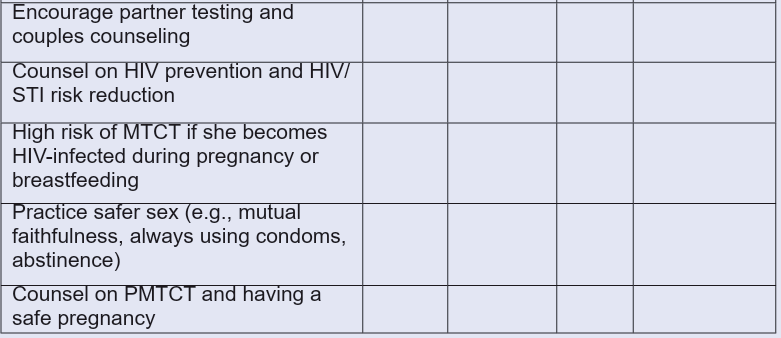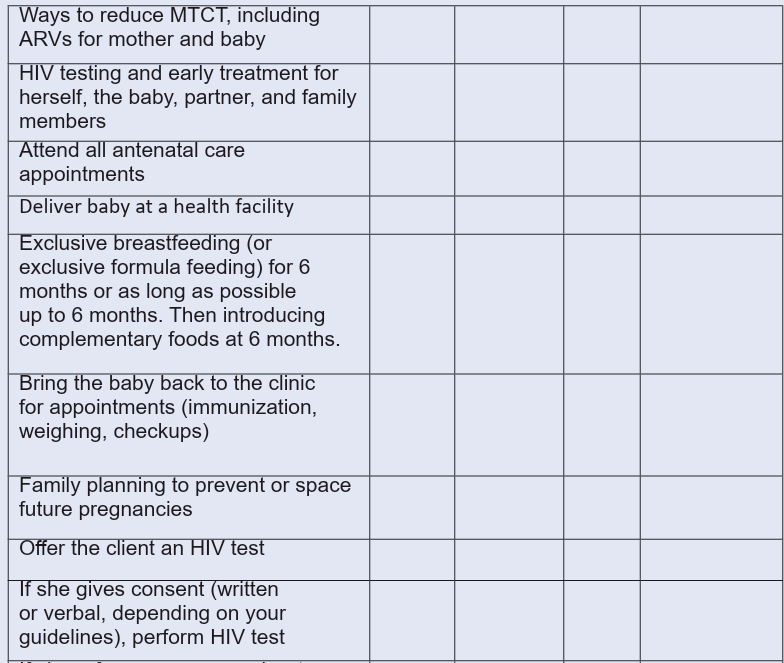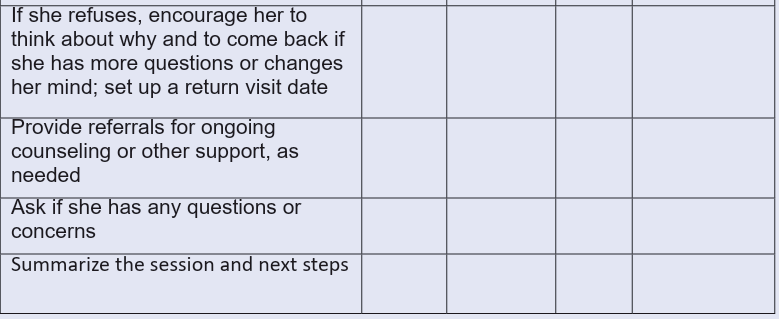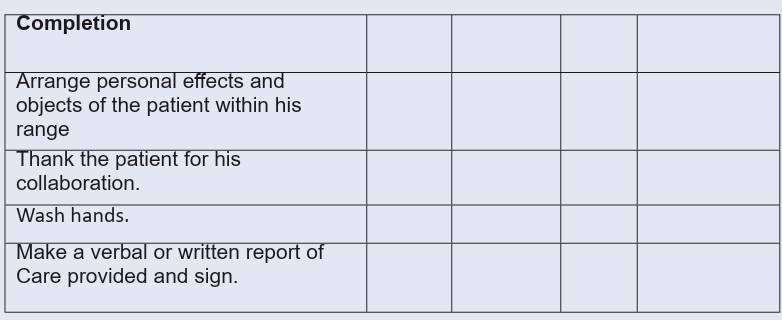UNIT 3: FUNDAMENTALS OF NURSING CLINICAL SKILLS SENIOUR FIVE
3.1. Procedure: Wound Dressing
3.1.1. Technique: Aseptic Dry Wound Dressing
Aims of aseptic wound dressing
• To keep the wound clean
• To prevent the wound from injury and contamination
• To keep in position, the drugs applied locally
• To keep the edges of the wound together
• To apply pressure
Learning outcomes:
• Maintain a sterile field
• Hand hygiene
• Glove use and other PPE
• Maintain aseptic field (sterile field) and non-touch technique
• Environmental controls
• Logical sequencing of the procedure.
• Hair tied back
• Wear closed shoes
• Hand washing
ASSOCIATE NURSE STUDENT / PREPARATION
• Should appear professional (in full and clean uniform) with student ID Card
• Remove watch, jewels, and Rings
Identification of the client
• Self-presentation to the client
• Physical and psychological client preparation
• Assess levels of comprehension and collaboration of the client
• Location, area, state of the wound.
• Type of dressing to carry out.
• Type of product to use.
Materials
• Cleaned and disinfected trolley.
• On the upper shelf of the trolley.
• Sterile dressing set : for the sterile scissors and forceps(1 anatomic and 1
Kocher), Gauze dressings, Sterile drape, Sterile kidney dish
• Serving forceps
• Specific and Additional Material: in drums, boxes, individual packing.
• Sterile cleaning solution as ordered (commonly 0.9% normal saline
solution)
• Tape or bandage
• Sanitizer for hand rub
• On the lower shelf of the trolley.
• Kidney dish
• Protective gloves.
• Waterproof pad
• Kidney basin with a pair of scissors for cutting the adhesive plaster..
• Container or Recipient for used material.
• Additional personal protective Equipment (PPE), as indicated• Dust bin





3.1.2. Technique: Wet Dressing Technique
AIMS
• To optimize timely and cosmetically appropriate healing
• Maintain a moist environment
• Control or absorb excess exudate, and aid debridement of necrotic or
slough tissue
• To prevent or combat infection non adherent to the wound surface, not to
shed fibres or cause trauma to the wound or surrounding tissue on removal
• Maintain a sterile field
• Hand hygiene
• Glove use and other PPE
• Environmental controls
• Maintain aseptic field (sterile field) and non-touch technique
• Logical sequencing of the procedure.
• Should appear professional (in full and clean uniform) with student ID Card
• Hair tied back
• Remove watch, jewels, and Rings
• Wear closed shoes
• Hand washing
Client preparation
• Identification of the client
• Self-presentation to the client
• Physical and psychological client preparation
• Assess levels of comprehension and collaboration of the client
• Location, area, state of the wound.
• Type of dressing to carry out.
• Type of product to use.,
Materials
• Cleaned and disinfected trolley.
On the upper shelf of the trolley.
• Sterile dressing set : for the sterile scissors and forceps(1 anatomic and 1
Kocher), Gauze dressings, Sterile drape, Sterile kidney dish
• Serving forceps
• Specific and Additional Material: in drums, boxes, individual packing.
• Sterile cleaning solution as ordered (commonly 0.9% normal saline solution)
• Tape or bandage
• Sanitizer for hand rub
On the lower shelf of the trolley.
• Kidney dish
• Protective gloves.
• Waterproof pad
• Dust bin.
• Kidney basin with a pair of scissors for cutting the adhesive plaster…
• Container or Recipient for used material.• Additional personal protective Equipment (PPE), as indicated








3.2. Procedure: Bandaging
3.2.1. Technique: Spiral Bandage
Aims of spiral bandage procedure is to:
• To minimize swelling in the initial management of injury
• To stop bleeding
• To immobilize the injured part of the body
• To Provide additional support to an injured structure of the wound together
• To apply pressure
Learning outcomes:
• Know the role of a nurse during Spiral bandaging;
• Know the methodology of Spiral technique
• Apply Spiral bandaging
• Substantiate compliance with the general principles of Spiral bandaging;
• Know the necessary aids used in Spiral bandaging
• Know the aid care procedure after Spiral bandaging;
Associate Nurse/student preparation
• Should appear professional (in full and clean uniform) with student ID
Card
• Hair tied back
• Remove watch, jewelries, and Rings
• Wear short and closed shoes
• Wash hands
Client preparation
• Identification of the patient
• Ensure client privacy
• Self-presentation to the patient
• Physical and psychological client preparation
• Assess levels of comprehension and collaboration of the patient
• Explain to the patient/ family the rational of technique
• Position the client in a comfortable position
EQUIPMENTS
• A clean tray
• 2 or many bandages of appropriate size.
• Gloves
• Adhesive plaster or safety pin.• Scissors (if adhesive plaster is used).



3.2.2. Technique : Spica Bandage
Aims of spica bandage procedure is to:
• To minimize swelling in the initial management of injury
• To stop bleeding
• To immobilize the injured part of the body
• To Provide additional support to an injured structure
Learning outcomes:
• Know the role of a nurse during Spica bandaging;
• Substantiate compliance with the general principles of Spica bandaging;
• Know the methodology of Spica technique
• Know the necessary aids used in Spica bandaging
• Apply Spica bandaging
• Know the aid care procedure after Spica bandaging;
ASSOCIATE NURSE STUDENT / PREPARATION
• Should appear professional (in full and clean uniform) with student ID card
• Hair tied back
• Remove watch, jewelries, and Rings
• Wear short and closed shoes
• Wash hands
Client preparation
• Identification of the patient
• Ensure client privacy
• Self-presentation to the patient
• Physical and psychological client preparation
• Assess levels of comprehension and collaboration of the patient
• Explain to the patient/ family the rational of technique
• Position the client in a comfortable position
EQUIPMENTS
• A clean tray
• 2 or many bandages of appropriate size.
• Gloves
• Adhesive plaster or safety pin.• Scissors (if adhesive plaster is used).

3.2.3. Technique: Earlobe Bandage
Aims of spica bandage procedure is to:
• To minimize swelling in the initial management of injury
• To stop bleeding
• To support a dressing to the ear
Learning outcomes:
• Know the role of a nurse during Earlobe bandaging;
• Substantiate compliance with the general principles of Earlobe bandaging;
• Know the methodology of Earlobe technique
• Know the necessary aids used in Earlobe bandaging
• Apply Earlobe bandaging
ASSOCIATE NURSE STUDENT / PREPARATION
• Should appear professional (in full and clean uniform) with student ID card
• Hair tied back
• Remove watch, jewelries, and Rings
• Wear short and closed shoes
• Wash hands
Client preparation
• Identification of the patient
• Ensure client privacy
• Self-presentation to the patient
• Physical and psychological client preparation
• Assess levels of comprehension and collaboration of the patient
• Explain to the patient/ family the rational of technique
• Position the client in a comfortable position
EQUIPMENTS
• A clean tray
• 2 or many bandages of appropriate size.
• Gloves
• Adhesive plaster or safety pin• Scissors (if adhesive plaster is used)


3.2.4. Technique: Cranial Bandage
Aims of monocular bandage procedure is to:
• To minimize swelling in the initial management of injury
• To stop bleeding• To support a dressing to the ear
Learning outcomes:
Associate Nurse/student preparation
• Should appear professional (in full and clean uniform) with student ID
Card
• Hair tied back
• Remove watch, jewelries, and Rings
• Wear short and closed shoes• Wash hands
Client preparation
• Identification of the patient
• Ensure client privacy
• Self-presentation to the patient
• Physical and psychological client preparation
• Assess levels of comprehension and collaboration of the patient
• Explain to the patient/ family the rational of technique• Position the client in a comfortable position
EQUIPMENTS
• A clean tray
• 2 or many bandages of appropriate size (Usually 1.5 to 2width).
• Gloves
• Adhesive plaster or safety pin.• Scissors (if adhesive plaster is used


3.2.5. Technique: Monocular Bandage (Right Or Left)
Aims of monocular bandage procedure is to:
• To stop bleeding
• To minimize swelling in the initial management of injury
• To support a dressing to the eye
Learning outcomes:
• Know the role of a nurse during monocular bandaging;
• Substantiate compliance with the general principles of monocular
bandaging;
• Know the methodology of monocular bandage technique
• Know the necessary aids used in monocular bandaging
• Apply monocular bandaging
Associate Nurse/student preparation
• Should appear professional (in full and clean uniform) with student ID card
• Hair tied back
• Remove watch, jewelries, and Rings
• Wear short and closed shoes
• Wash hands
Client preparation
• Identification of the patient
• Ensure client privacy
• Self-presentation to the patient
• Physical and psychological client preparation
• Assess levels of comprehension and collaboration of the patient
• Explain to the patient/ family the rational of technique
• Position the client in a comfortable position
EQUIPMENTS
• A clean tray
• 2 or many bandages of appropriate size (Usually 1.5 to 2width).
• Gloves
• Adhesive plaster or safety pin.• Scissors (if adhesive plaster is used


3.2.6. Technique: Binocular Bandage
Aims of binocular bandage procedure is to:
• To minimize swelling in the initial management of injury
• To stop bleeding• To support a dressing to the eyes
Learning outcomes:
• Know the role of a nurse during binocular bandaging;
• Substantiate compliance with the general principles of binocular bandaging;
• Know the methodology of binocular bandage technique
• Know the necessary aids used in binocular bandaging
• Apply binocular bandaging
Associate Nurse/student preparation
• Should appear professional (in full and clean uniform) with student ID card
• Hair tied back
• Remove watch, jewelries, and Rings
• Wear short and closed shoes
• Wash hands
Client preparation
• Identification of the patient
• Ensure client privacy
• Self-presentation to the patient
• Physical and psychological client preparation
• Assess levels of comprehension and collaboration of the patient
• Explain to the patient/ family the rational of technique
• Position the client in a comfortable position
EQUIPMENTS
• A clean tray
• 2 or many bandages of appropriate size (Usually 1.5 to 2width).
• Gloves
• Adhesive plaster or safety pin.• Scissors (if adhesive plaster is used).


3.2.7. Technique: Hand Gloved Bandage
Aims of hand gloved bandage procedure is to:
• To minimize swelling in the initial management of injury
• To stop bleeding
• To support a dressing to the fingers
Learning outcomes:
• Know the role of a nurse during hand gloved bandaging;
• Substantiate compliance with the general principles of hand gloved
bandaging;
• Know the methodology of hand gloved bandage technique
• Know the necessary aids used in hand gloved bandaging
• Apply hand gloved bandaging
Associate Nurse/student preparation
• Should appear professional (in full and clean uniform) with student ID
Card
• Hair tied back
• Remove watch, jewelries, and Rings
• Wear short and closed shoes
• Wash hands
Client preparation
• Identification of the patient
• Ensure client privacy
• Self-presentation to the patient
• Physical and psychological client preparation
• Assess levels of comprehension and collaboration of the patient
• Explain to the patient/ family the rational of technique
• Position the client in a comfortable position
EQUIPMENTS
• A clean tray
• 2 or many bandages of appropriate size (Usually 1.5 to 2width).
• Gloves
• Adhesive plaster or safety pin.• Scissors (if adhesive plaster is used).


3.2.8. Technique: Triangular Bandage
Aims of triangular bandage procedure is to:
• To minimize swelling in the initial management of injury
• To support and immobilize fractured forearm
• To support and immobilize shoulder luxation
Learning outcomes:
• Know the role of a nurse during triangular bandaging;
• Substantiate compliance with the general principles of hand gloved
bandaging;
• Know the methodology of triangular bandage technique
• Know the necessary aids used in triangular bandaging
• Apply triangular bandaging
Associate Nurse/student preparation
• Should appear professional (in full and clean uniform) with student ID card
• Hair tied back
• Remove watch, jewelries, and Rings
• Wear short and closed shoes
• Wash hands
Client preparation
• Identification of the patient
• Ensure client privacy
• Self-presentation to the patient
• Physical and psychological client preparation
• Assess levels of comprehension and collaboration of the patient
• Explain to the patient/ family the rational of technique
• Position the client in a comfortable position
EQUIPMENTS
• A clean tray
• 2 or many bandages of appropriate size (Usually 1.5 to 2width).
• Gloves
• Safety pins.• Scissors (if adhesive plaster is used).

3.2.9. Technique: Stump Bandage
Aims of stump bandage procedure is to:
• To minimize swelling in the initial management of injury
• To stop bleeding
• To support a dressing
Learning outcomes:
• Know the role of a nurse during Stump bandaging;
• Substantiate compliance with the general principles of Stump bandaging;
• Know the methodology of Stump bandage technique
• Know the necessary aids used in Stump bandaging
• Apply Stump bandaging
Associate Nurse/student preparation
• Should appear professional (in full and clean uniform) with student ID card
• Hair tied back
• Remove watch, jewelries, and Rings
• Wear short and closed shoes
• Wash hands
Client preparation
• Identification of the patient
• Ensure client privacy
• Self-presentation to the patient
• Physical and psychological client preparation
• Assess levels of comprehension and collaboration of the patient
• Explain to the patient/ family the rational of technique
• Position the client in a comfortable position
EQUIPMENTS
• A clean tray
• 2 or many bandages of appropriate size (Usually 1.5 to 2width).
• Gloves
• Safety pins.• Scissors (if adhesive plaster is used).


3.3. Procedure: Basic Laboratory Tests
3.3.1. Technique: Rapid Test for Malaria
AIMS
• Diagnosis of malaria by detecting evidence of malaria parasites (antigens)
in human blood.
Learning Outcomes
• Able to explain the steps of rapid test of malaria
• Perform the procedure with respect of procedure sequence
• Able to interpret results of rapid test of malaria
Associate Nurse/student preparation
• Hair tied back
• Remove watch, jewelries, and Rings
• Should appear professional (in full and clean uniform) with student ID Card
• Wear short and closed shoes
• Wash hands
Client preparation
• Identification of the patient
• Ensure client privacy
• Self-presentation to the patient
• Physical and psychological client preparation
• Assess levels of comprehension and collaboration of the patient
• Explain to the patient/ family the rationale of technique
• Position the client in a comfortable position
Materials preparation
• Gloves
• Rapid Diagnostic Test (RDT) kit
• Safety box
• Dustbin• Timer

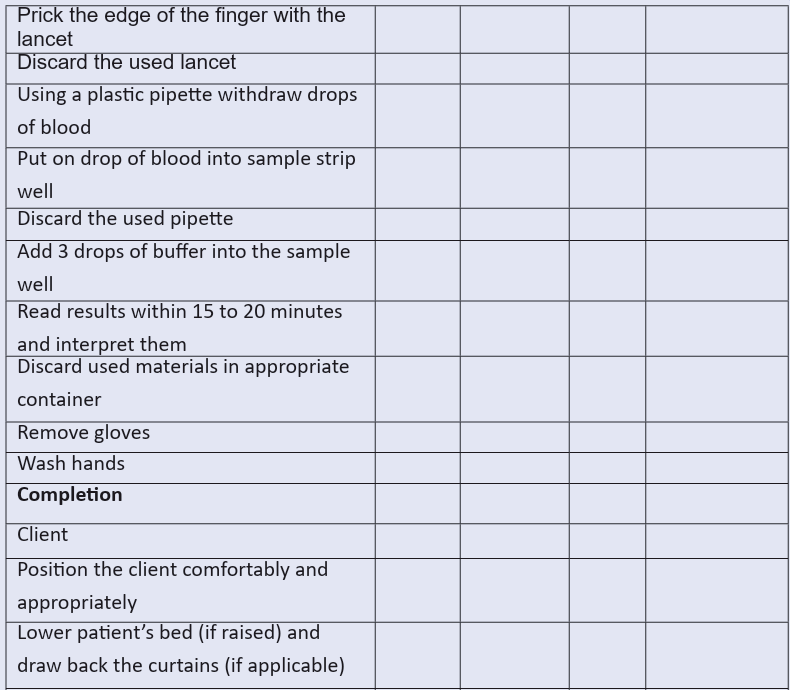
3.3.2. Technique: Performing urine test (albumin, glucose)
AIMS
• Introduce urinalysis testing procedures,
• Apply clinical correlation of the results with the diseases.
Learning Outcomes
• Able to collect urine specimen adequately and follow routine urinalysis
procedures
• Perform urinalysis respecting steps, report findings according to laboratory
protocol
• Recognize normal and abnormal urinalysis test results and correlate with
the diseases.
Associate Nurse/student preparation
• Should appear professional (in full and clean uniform) with student ID
Card
• Hair tied back
• Remove watch, jewelries, and Rings
• Wear short and closed shoes
• Wash hands
Client preparation
• dentification of the patient
• Ensure client privacy
• Self-presentation to the patient
• Physical and psychological client preparation
• Assess levels of comprehension and collaboration of the patient
• Explain to the patient/ family the rational of technique• Position the client in a comfortable position

3.3.3. Technique: Performing glycemia test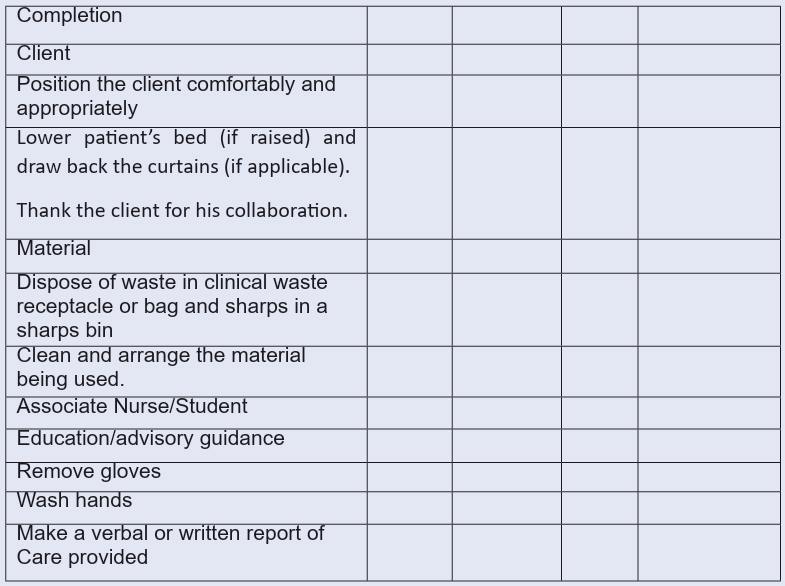
AIMS
• Monitor the effect of diabetes medications on blood sugar levels
• Identify blood sugar levels that are high or low
• Track progress in reaching overall treatment goals
• Learn how diet and exercise affect blood sugar levels
Learning Outcomes
• Perform glycemia test by respecting steps, report findings according to
laboratory protocol
• Recognize normal and abnormal glycemia test results and correlatewith the diseases.
Preparation
Associate Nurse/student preparation
• Should appear professional (in full and clean uniform) with student ID
Card
• Hair tied back
• Remove watch, jewelries, and Rings
• Wear short and closed shoes
• Wash hands
Client preparation
• Identification of the patient
• Ensure client privacy
• Self-presentation to the patient
• Physical and psychological client preparation
• Assess levels of comprehension and collaboration of the patient
• Explain to the patient/ family the rational of technique
• Position the client in a comfortable position
Materials preparation
• Blood glucose monitor (Glucometer)
• Test strips (check that they are in date and have not been exposed to the air)
• Alcohol swab
• Single-use safety lancets or lancing device,
• Gloves,
• Cotton wool/gauze,• Sharps box or safety box,
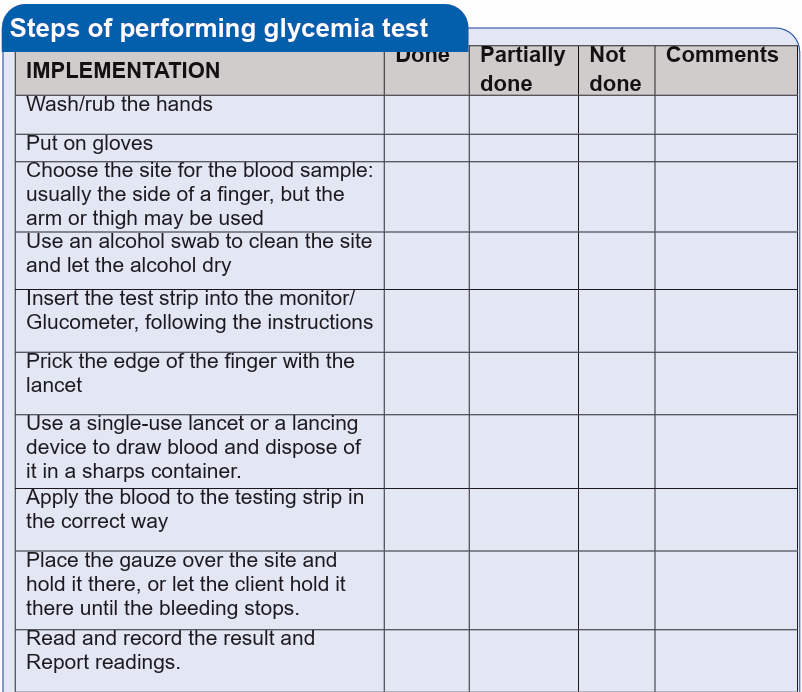
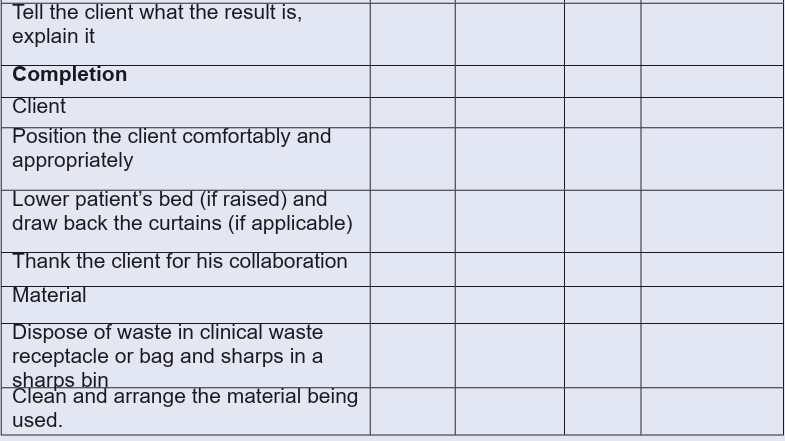
3.5.First Aid
3.4.1. Technique: Putting the victim into the recovery position
AIMS
• Prevent suffocation through obstruction of the airway
Learning Outcomes
• Able to understand and describe how the technique of putting the victim
into the recovery position is done
• Maintain comfort and safety during the procedure
• Perform the procedure by respecting the steps
Preparation
Associate Nurse/student preparation
• Should appear professional (in full and clean uniform) with
student ID Card
• Hair tied back
• Remove watch, jewelries, and Rings
• Wear short and closed shoes
• Wash hands if applicable
• Client preparation
Client preparation
• dentification of the patient
• Ensure client privacy if applicable
• Self-presentation to the patient if applicable
• Physical and psychological client preparation if applicable
• Assess levels of comprehension and collaboration of the patient if
applicable
• Explain to the patient/ family the rational of technique if applicable
• Position the client in a comfortable position if applicable
Materials preparation
• Materials
• A clean tray if applicable• Gloves if available
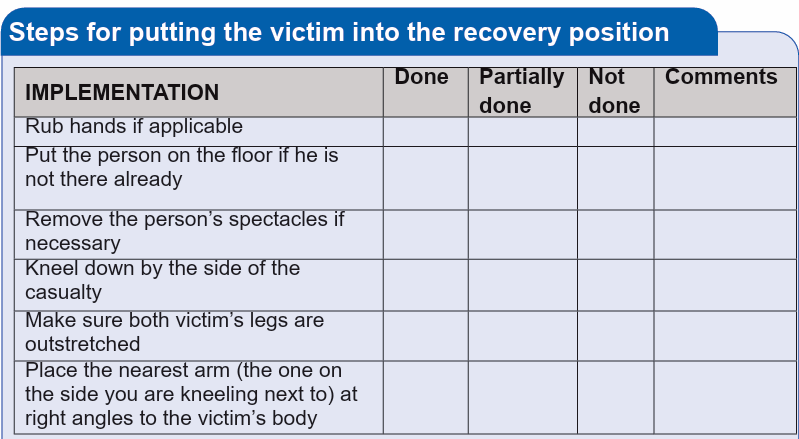

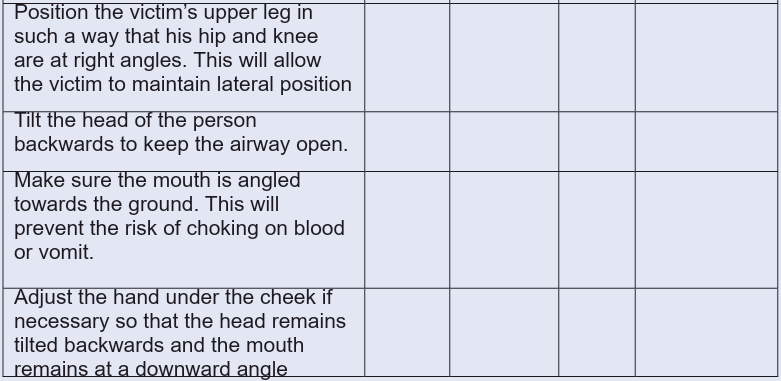
3.4.2. Technique: First aid interventions in case of burn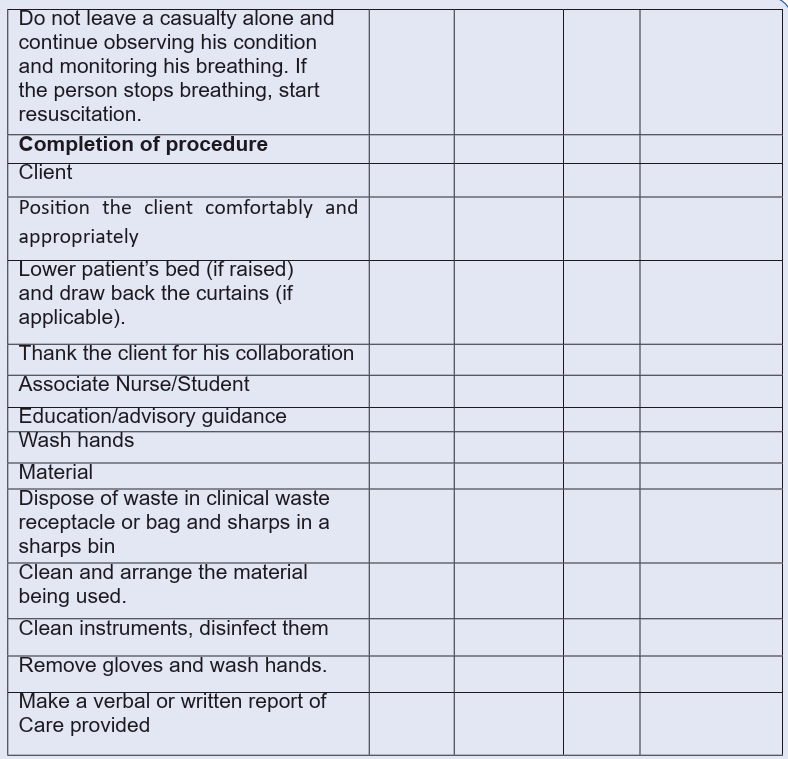
AIMS
• Protect the burned person from further harm
Learning Outcomes
• Able to understand and describe how the technique of first aid in case of burn
• Maintain comfort and safety during the procedure
• Perform the procedure by respecting the stepsPreparation
Associate Nurse/student preparation
• Should appear professional (in full and clean uniform) with
student ID Card
• Hair tied back
• Remove watch, jewelries, and Rings
• Wear short and closed shoes
• Wash hands
Client preparation
• Identification of the patient if applicable
• Ensure client privacy if applicable
• Self-presentation to the patient if applicable
• Physical and psychological client preparation if applicable
• Assess levels of comprehension and collaboration of the
patient if applicable
• Explain to the patient/ family the rational of technique if
applicable
• Position the client in a comfortable position if applicable
Materials
• A clean tray if applicable
• Gloves if applicable
• Tape water
• personal protective equipment if applicable
• Antibiotic / burn cream if available• Bandages if available
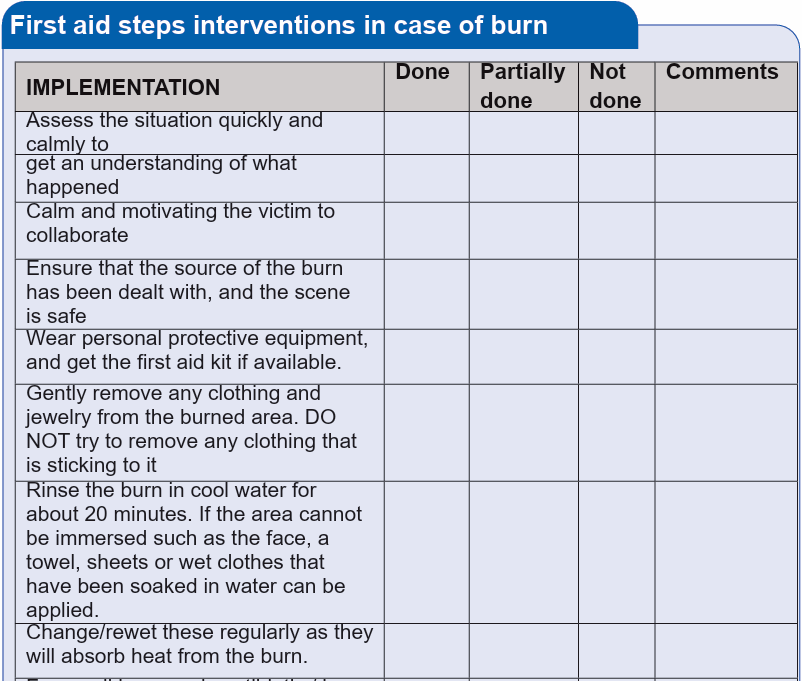

3.4.3. Technique: First aid in case of Drowning
AIMS
• Treat the victim for hypothermia
• To help the victim to regain the normal breathing
Learning Outcomes
• Able to understand and describe how the technique of helping drowned
person is done
• Maintain comfort and safety during the procedure• Perform the procedure by respecting the steps
Preparation
Associate Nurse/student preparation
• Hair tied back
• Should appear professional (in full and clean uniform) with student ID
Card
• Remove watch, jewelries, and Rings
• Wear short and closed shoes
• Wash hands
Client preparation
• Identification of the patient if applicable
• Ensure client privacy if applicable
• Self-presentation to the patient if applicable
• Physical and psychological client preparation if applicable
• Assess levels of comprehension and collaboration of the patient if applicable
• Explain to the patient/ family the rational of technique if applicable• Position the client in a comfortable position if applicable
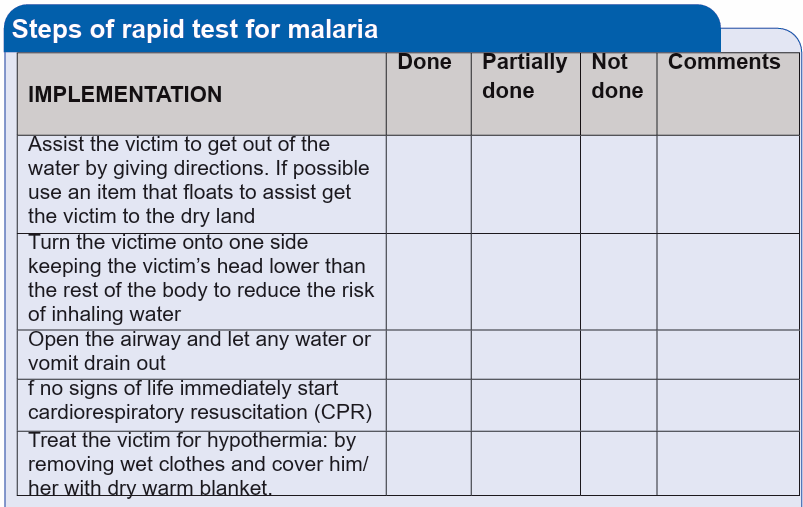
3.6.Technique: Choking relief in a responsive adult or child
AIMS
• To remove the foreign object lodged in the throat in order to clear
airways
• To provide first aid as quickly as possible.
Learning Outcomes
• Able to perform abdominal thrusts (Heimlich maneuver)
Associate Nurse/student preparation
• Hair tied back
• Should appear professional (in full and clean uniform) with student ID
Card
• Remove watch, jewelries, and Rings
• Wear short and closed shoes
• Wash hands
Preparation
Client preparation
• Identification of the patient if applicable
• Ensure client privacy if applicable
• Self-presentation to the patient if applicable
• Physical and psychological client preparation if applicable
• Assess levels of comprehension and collaboration of the patient if applicable
• Explain to the patient/ family the rational of technique if applicable
• Position the client in a comfortable position if applicable
Materials• Gloves if available

3.4.5. Technique: Choking relief in an unresponsive adult or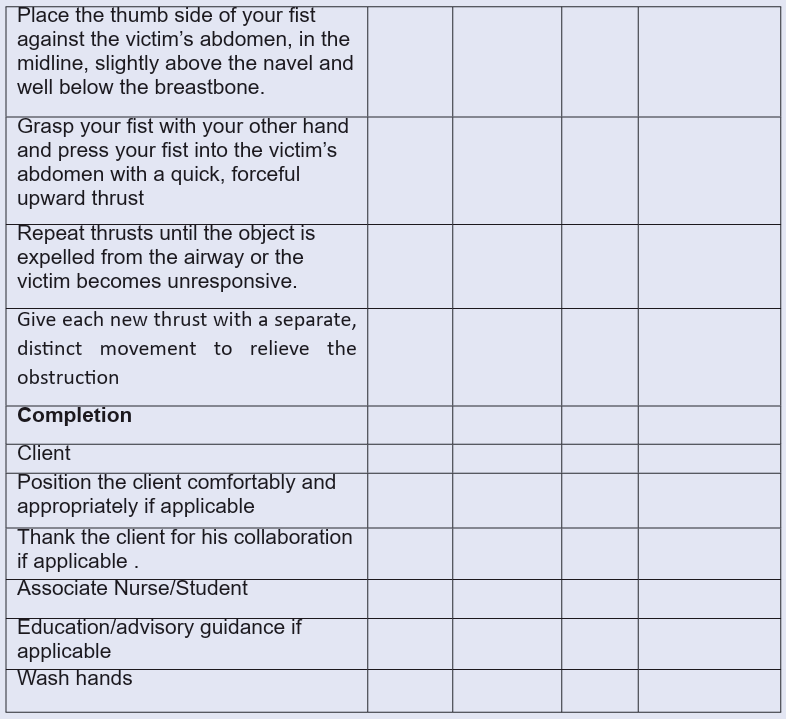
child
AIMS
• To remove the foreign object lodged in the throat in order to clear airways
• To provide first aid as quickly as possible.
Learning Outcomes
• Able to perform abdominal thrusts (Heimlich maneuver).
Preparation
Associate Nurse/student preparation
• Hair tied back
• Should appear professional (in full and clean uniform) with student ID
Card
• Remove watch, jewelries, and Rings
• Wear short and closed shoes
• Wash hands
Client preparation
• Identification of the patient if applicable
• Ensure client privacy if applicable
• Self-presentation to the patient if applicable
• Physical and psychological client preparation if applicable
• Assess levels of comprehension and collaboration of the patient if applicable
• Explain to the patient/ family the rational of technique if applicable
• Position the client in a comfortable position if applicable
Materials• Gloves if available
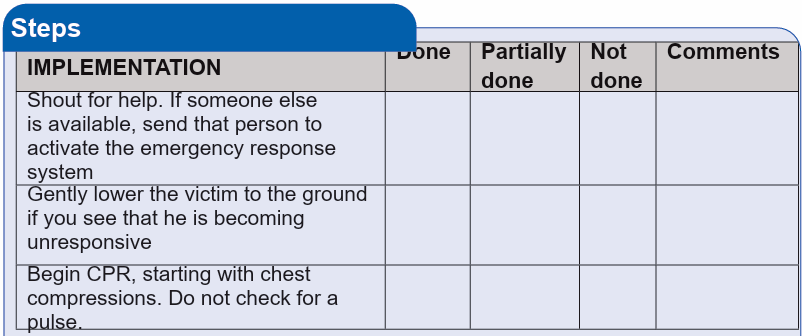

3.7.Choking relief in infants (Back slaps and chest
thrusts)
AIMS
• To remove the foreign object lodged in the throat in order to clear airways
• To provide first aid as quickly as possible.
Learning Outcomes
• Able to perform abdominal thrusts (Heimlich maneuver).
Preparation
Associate Nurse/student preparation
• Should appear professional (in full and clean uniform) with student ID
Card
• Hair tied back
• Remove watch, jewelries, and Rings
• Wear short and closed shoes
• Wash hands
Client preparation
• Identification of the patient if applicable.
• Ensure client privacy if applicable.
• Self-presentation to the patient or family if applicable.
• Physical client preparation if applicable.
• Explain to the patient/ family the rational of technique if applicable.
• Position the client in a required position
Materials• Gloves if available
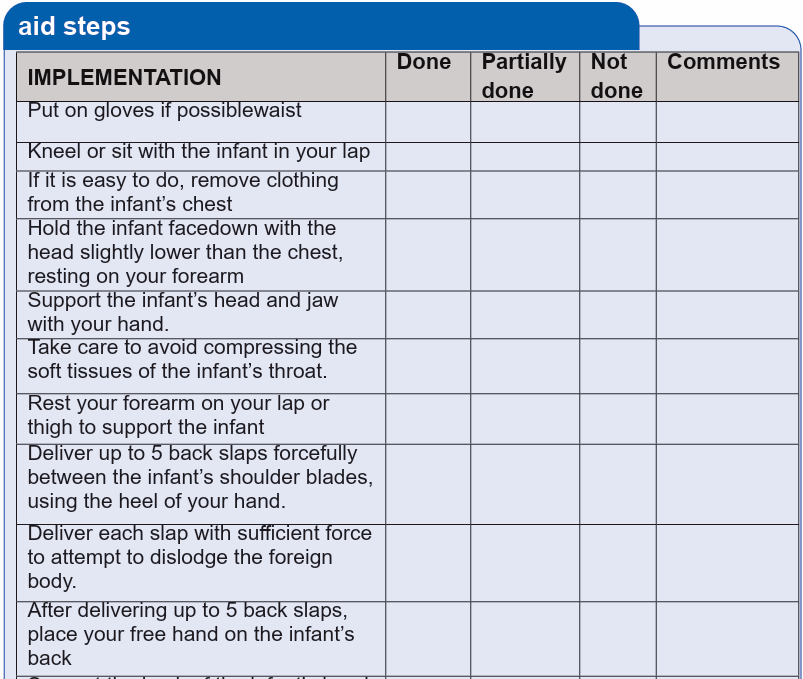
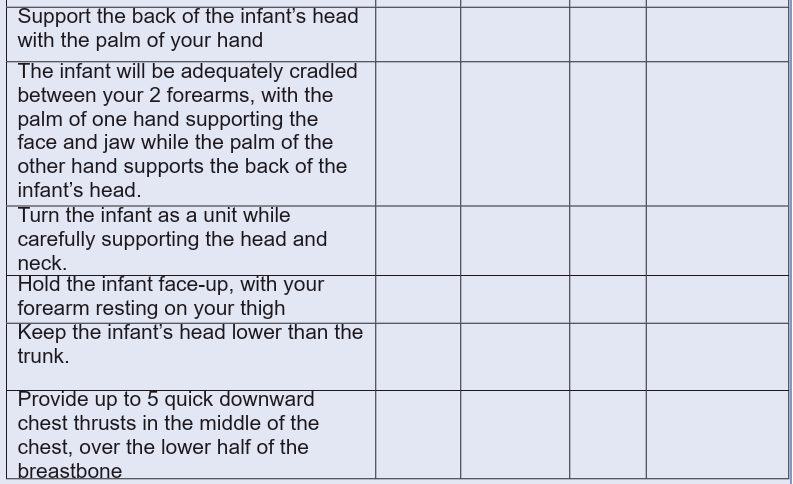
3.4.7. Choking Relief in an Unresponsive Infant AIMS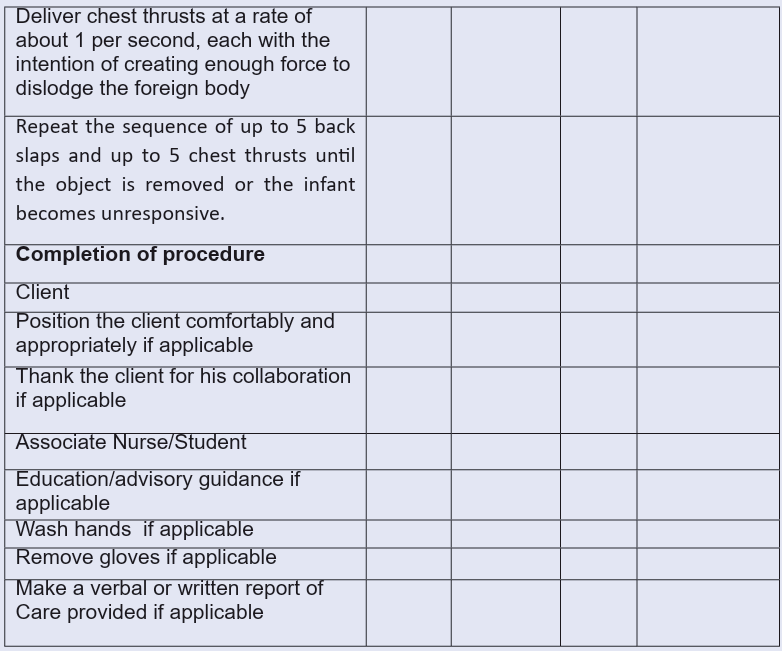
• o remove the foreign object lodged in the throat in order to clear airways
• To provide first aid as quickly as possible.
Learning Outcomes
• Able to perform abdominal thrusts (Heimlich maneuver).
Preparation
Associate Nurse/student preparation
• Should appear professional (in full and clean uniform) with student ID Card
• Hair tied back
• Remove watch, jewelries, and Rings
• Wear short and closed shoes
• Wash hands
Client preparation
• Identification of the patient if applicable.
• Ensure client privacy if applicable.
• Self-presentation to the patient or family if applicable.
• Physical client preparation if applicable.
• Explain to the patient/ family the rational of technique if applicable.• Position the client in a required position
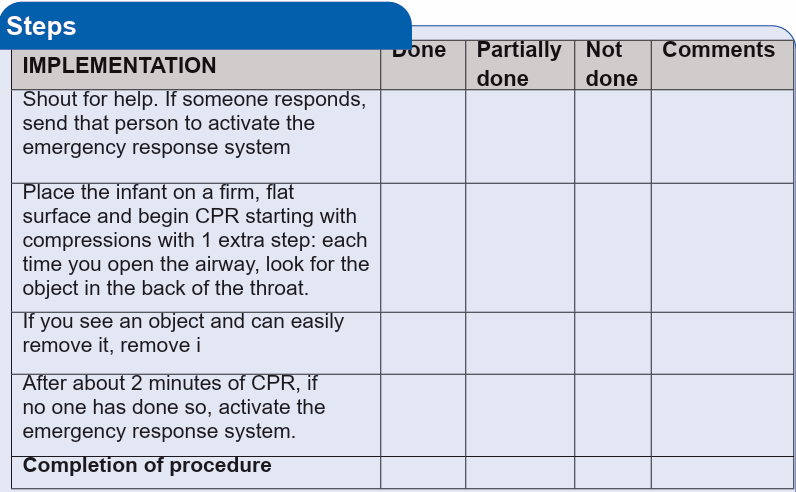
3.8.Technique: Cardiorespiratory Resuscitation: CPR
AIMS
• To restore partial flow of oxygenated blood to the brain and heart
• To delay tissue death including permanent brain damage.
Learning Outcomes
• The student will be able to provide CPR effectively.
Preparation
Associate Nurse/student preparation
• Should appear professional (in full and clean uniform) with
student ID Card
• Hair tied back
• Remove watch, jewelries, and Rings
• Wear short and closed shoes
• Wash hands
Client preparation
• Identification of the patient if applicable.
• Ensure client privacy if applicable.
• Self-presentation to the patient or family if applicable.
• Physical client preparation if applicable.
• Explain to the patient/ family the rational of technique if applicable.
• Position the client in a required position
Materials
• Gloves if available• AED if available



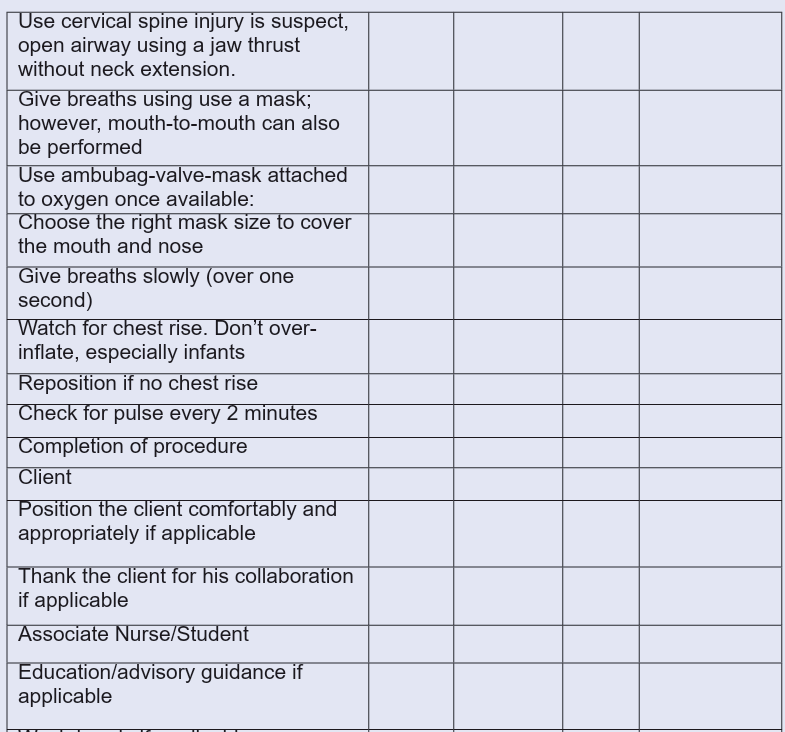
3.4.9. First aid care for broken bones
AIMS
• To rescue the patient’s life,
• To protect the affected limb
• To Stop any bleeding.
• To transport it safely and quickly in a simple and effective way in order to
get proper treatment
Learning Outcomes
• To Immobilize the injured area.
• To limit swelling and help relieve pain
Associate Nurse/student preparation
• Should appear professional (in full and clean uniform) with student ID
Card
• Hair tied back
• Remove watch, jewelries, and Rings
• Wear short and closed shoes
• Wash hands
Client preparation
• Identification of the patient
• Ensure client privacy
• Self-presentation to the patient
• Physical and psychological client preparation
• Assess levels of comprehension and collaboration of the patient
• Explain to the patient/ family the rational of technique
• Position the client in a comfortable position
Preparation
Materials
• Gloves
• Gauze
• Wood
• Splint material
• Tape• Triangular arm sling

3.9.First aid in case of Epileptic seizure
AIMS
• keeping the person safe until the seizure stops
Learning Outcomes
• To Stay calm,
• To Loosen anything around the person’s neck,
• To Clear the area around
• To Stay with patient after the seizure stops
Associate Nurse/student preparation
• Should appear professional (in full and clean uniform) with student ID
Card
• Hair tied back
• Remove watch, jewelries, and Rings
• Wear short and closed shoes
• Wash hands
Client preparation
• Identification of the patient
• Ensure client privacy
• Self-presentation to the patient
• Physical and psychological client preparation
• Assess levels of comprehension and collaboration of the patient
• Explain to the patient/ family the rational of technique
• Position the client in a comfortable position
Materials• Gloves
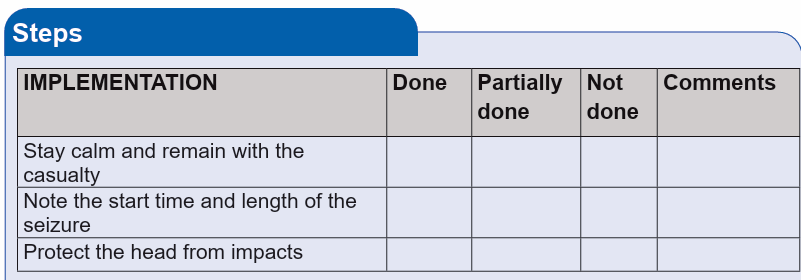
1.10.Technique: Immediate Post Natal Care Of The Mother
AIMS
• To have the general picture of the mother’s well being
• To find out the level of consciousness
• To find out if the woman’s condition gives rise to concern
• To find out the woman’s urgent need of care
Learning Outcomes
• Monitor a mother during postnatal period
Associate Nurse/student preparation
• Should appear professional (in full and clean uniform) with student ID Card
• Hair tied back and put bonnet
• Assemble equipment and arrange on bedside chair in the order the items
will be used
• Remove watch, jewels, and Rings
• Respect dignity and privacy of the client
• Wear closed and short shoes
• Hand washing
Client preparation
• Identification of the patient
• Self-presentation to the patient
• Physical and psychological patient preparation
• Assess levels of comprehension and collaboration of the patient
• Explain to the patient/ family the rationale
• Position the patient in a comfortable position
• Ensure privacy
Equipment
• Vital signs materials
• Examination gloves
• Gauze
• Kit for vulva disinfection
• Dustbin, and
• Examination table and folding/curtain screen if necessary• Sanitary pad


3.11.4.2. Technique: Pre HIV Testing Counselling For Pregnant Woman (PMTCT)
AIMS
• To ensure primary prevention of HIV among women of childbearing age
• To integrate PMTCT interventions into routine maternal and child’s health
services
Learning Outcomes
• To promote voluntary testing in the context of PMTCT when offering
antenatal care.
• To provide appropriate regimens to prevent mother-to-child transmission
• To Provide psychosocial support to HIV positive pregnant women.• Improving follow-up care for HIV positive women and their infants.
Associate Nurse/student preparation
• Hair tied back and put bonnet
• Should appear professional (in full and clean uniform) with student ID Card
• Assemble equipment and arrange on bedside chair in the order the items
will be used
• Remove watch, jewels, and Rings
• Respect dignity and privacy of the client
• Wear closed and short shoes
• Hand washing
Patient preparation
• Identification of the patient
• Self-presentation to the patient
• Physical and psychological patient preparation
• Assess levels of comprehension and collaboration of the patient
• Explain to the patient/ family the rationale
• Position the patient in a comfortable position• Ensure privacy


